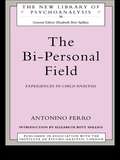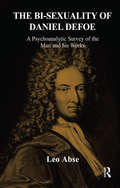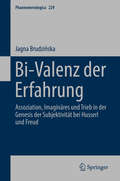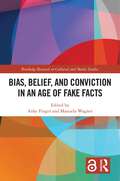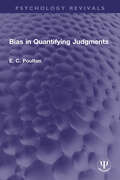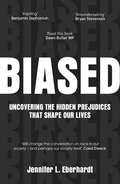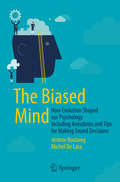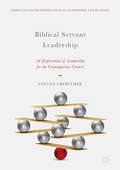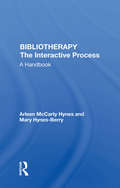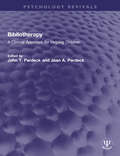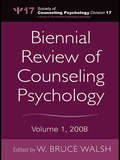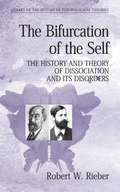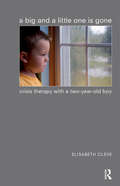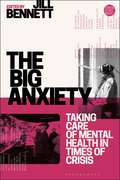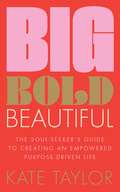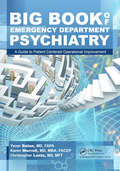- Table View
- List View
The Bi-Personal Field: Experiences in Child Analysis (The New Library of Psychoanalysis)
by Antonino FerroIn The Bi-Personal Field Antonino Ferro sets out his new conceptual system for analysis, considering not only the inner world of the patient but the continued interaction of that world with the inner world of the analyst. The book takes a fresh look at the main aspects of theory and technique in psychoanalysis in the light of Kleinian developments. It reflects the drastic changes due to the thinking of Bion. Illustrated with numerous detailed clinical examples, the author claims that the basic focus of the analytic relationship is the conscious and unconscious interpersonal/ intersubjective processes going on between the analyst and patient.
The Bi-sexuality of Daniel Defoe: A Psychoanalytic Survey of the Man and His Works
by Leo AbseThis book presents an intriguing and novel Freudian overview of all Daniel Defoe's major works by confronting various psychoanalytic hypotheses regarding Defoe. It is an original, well-documented, and compelling cross-disciplinary approach to identity issues and creative genius of Defoe.
The Bi-sexuality of Daniel Defoe: A Psychoanalytic Survey of the Man and His Works
by Leo AbseThis book presents an intriguing and novel Freudian overview of all Daniel Defoe's major works by confronting various psychoanalytic hypotheses regarding Defoe. It is an original, well-documented, and compelling cross-disciplinary approach to identity issues and creative genius of Defoe.
Bi-Valenz der Erfahrung: Assoziation, Imaginäres und Trieb in der Genesis der Subjektivität bei Husserl und Freud (Phaenomenologica #229)
by Jagna BrudzińskaEdmund Husserls Phänomenologie und Sigmund Freuds Psychoanalyse sind zwei große Denktraditionen des 20. Jahrhunderts. Erstmals wird in diesem Buch die lebendige problemgebundene Beziehung zwischen beiden untersucht, und zwar ausgehend von Husserls genetischer Phänomenologie. Im Fokus stehen drei große Erfahrungsbereiche des Menschen: die Assoziation, die Phantasie und der Trieb. Wie sich zeigt, spielen alle drei eine Schlüsselrolle, sowohl für Husserls als auch für Freuds Denken.Die Autorin hat für ihre Studie veröffentlichte wie auch unveröffentlichte Texte aus dem Werk Husserls berücksichtigt und die Ergebnisse lassen die Phänomenologie in einem neuen Licht erscheinen. So rücken in diesem Buch, anders als im allgemein-philosophischen Verständnis von Intentionalität, spezifische Formen der phantasmatischen und imaginären Intentionalität in den Vordergrund. Auf diese Weise betrachtet, zeigt sich die subjektive Erfahrung als eine menschliche Entwicklungsstruktur, die unter einer doppelten Ordnung steht: Wir und unsere Welt sind nicht nur durch Wahrnehmung strukturiert, sondern auch durch imaginäre Leistungen, durch triebhafte Tendenzen und unbewusste Wünsche. Die Autorin findet dafür den Begriff der Bi-Valenz, der Zweiwertigkeit der personalen Realität.Mit dieser Untersuchung werden zwei Ziele erreicht. Einerseits befreit die Autorin das Trieb-Verständnis der Psychoanalyse von seinem naturalistischen Rest, andererseits eröffnet sie für die Phänomenologie einen neuen Bereich anschaulicher Erfahrung: das dynamische Unbewusste. Das Medium dieser Erfahrung ist eine starke, produktive Phantasie, die aus triebhaften Quellen schöpft und unsere Realität mit-gestaltet. Der Band richtet sich an Studierende und Wissenschaftler, die sich für genetische Phänomenologie und die Philosophie der Psychoanalyse interessieren.
Bias, Belief, and Conviction in an Age of Fake Facts (Routledge Research in Cultural and Media Studies)
by Anke Finger Manuela WagnerIn this book, authors engage in an interdisciplinary discourse of theory and practice on the concept of personal conviction, addressing the variety of grey zones that mark the concept. Bias, Belief, and Conviction in an Age of Fake Facts discusses where our convictions come from and whether we are aware of them, why they compel us to certain actions, and whether we can change our convictions when presented with opposing evidence, which prove our personal convictions "wrong". Scholars from philosophy, psychology, comparative literature, media studies, applied linguistics, intercultural communication, and education shed light on the topic of personal conviction, crossing disciplinary boundaries and asking questions not only of importance to scholars but also related to the role and possible impact of conviction in the public sphere, education, and in political and cultural discourse. By taking a critical look at personal conviction as an element of inquiry within the humanities and social sciences, this book will contribute substantially to the study of conviction as an aspect of the self we all carry within us and are called upon to examine. It will be of particular interest to scholars in communication and journalism studies, media studies, philosophy, and psychology.
Bias, Belief, and Conviction in an Age of Fake Facts (Routledge Research in Cultural and Media Studies)
by Manuela Wagner Anke FingerIn this book, authors engage in an interdisciplinary discourse of theory and practice on the concept of personal conviction, addressing the variety of grey zones that mark the concept. Bias, Belief, and Conviction in an Age of Fake Facts discusses where our convictions come from and whether we are aware of them, why they compel us to certain actions, and whether we can change our convictions when presented with opposing evidence, which prove our personal convictions "wrong". Scholars from philosophy, psychology, comparative literature, media studies, applied linguistics, intercultural communication, and education shed light on the topic of personal conviction, crossing disciplinary boundaries and asking questions not only of importance to scholars but also related to the role and possible impact of conviction in the public sphere, education, and in political and cultural discourse. By taking a critical look at personal conviction as an element of inquiry within the humanities and social sciences, this book will contribute substantially to the study of conviction as an aspect of the self we all carry within us and are called upon to examine. It will be of particular interest to scholars in communication and journalism studies, media studies, philosophy, and psychology.
Bias in Quantifying Judgments (Psychology Revivals)
by E. C. PoultonOriginally published in 1989, this volume carefully catalogues and classifies the effect of bias on quantitative judgments. Each bias is described by model and examples of this bias are given. The examples include both theoretical investigations carried out in the laboratory to study bias and practical illustrations. They are accompanied by a discussion of methods of avoiding bias, where this is possible. An early look into this now widely recognised subject, this book was an invaluable resource for investigators and practitioners in applied science at the time.
Bias in Quantifying Judgments (Psychology Revivals)
by E. C. PoultonOriginally published in 1989, this volume carefully catalogues and classifies the effect of bias on quantitative judgments. Each bias is described by model and examples of this bias are given. The examples include both theoretical investigations carried out in the laboratory to study bias and practical illustrations. They are accompanied by a discussion of methods of avoiding bias, where this is possible. An early look into this now widely recognised subject, this book was an invaluable resource for investigators and practitioners in applied science at the time.
Biased: Uncovering The Hidden Prejudice That Shapes What We See, Think, And Do
by Dr Jennifer Eberhardt'Jennifer Eberhardt makes it clear that racism operates at all levels, and it fills me with hope to know that she is fighting it at all levels. More power to you, sister. The world needs you.' BENJAMIN ZEPHANIAH'A critically important book.' DAVID OLUSOGA, author of Black and British'Jennifer Eberhardt’s ground-breaking work has the power to shift the debate and help shape a fairer society.' DAVID LAMMY MP‘Jennifer Eberhardt gives us the opportunity to talk about race in new ways, ultimately transforming our thinking about ourselves and the world we want to create.’ MICHELLE ALEXANDER, author of The New Jim Crow‘Groundbreaking... essential reading for anyone interested in how we become a more just society.’ BRYAN STEVENSON, author of Just Mercy‘An illuminating and readable account of how racial stereotypes and assumptions can cause social devastation and keep huge inequalities in place.’ DR PRIYAMVADA GOPAL, University of Cambridge'This books should be required reading for everyone.' ROBIN DIANGELO, author of White Fragility'Read this book. Biased will enlighten your journey through race relations and associations.’ DAWN BUTLER MP______________________From one of the world’s leading experts on unconscious racial bias comes a landmark examination of one of the most culturally powerful issues of our time.We might think that we treat all people equally, but we don’t. Every day, unconscious biases affect our visual perception, attention, memory and behaviour in ways that are subtle and very difficult to recognise without in-depth scientific studies.Unconscious biases can be small and insignificant, but they affect every sector of society, leading to enormous disparities, from the classroom to the courtroom to the boardroom.But unconscious bias is not a sin to be cured, but a universal human condition, and one that can be overcome.In Biased, pioneering social psychologist Professor Jennifer Eberhardt explains how.
The Biased Mind: How Evolution Shaped our Psychology Including Anecdotes and Tips for Making Sound Decisions
by Jérôme Boutang Michel De LaraUsing a wealth of anecdotes, data from academic literature, and original research, this very accessible little book highlights how we all struggle to cope with the maelstrom of choices, influences and experiences that come our way. The authors have slogged through piles of dry research papers to provide many wonderful nuggets of information and surprising insights. For example: Why is an upside-down red triangle such a powerful warning sign on the road? What is the best kind of alibi? What makes the number 7 so special? Why is it better to whisper words of love into the left ear? Will that recent marriage last? Why is it that the French eat snails but not slugs? The reader will discover the amazing tools and shortcuts that millennia of evolution have built into our brains. And this knowledge is power! Knowing more about how the human mind connects the dots helps us understand why decision-making is so tricky. With insights from evolutionary psychology, we become better equipped to understand ourselves and others and to interact and communicate more effectively.
Biblical Servant Leadership: An Exploration of Leadership for the Contemporary Context (Christian Faith Perspectives in Leadership and Business)
by Steven CrowtherThis book explores the concepts from Scripture for Servant leadership and compare these findings with contemporary models of servant leadership. It is an examination of Christian leadership for the contemporary world in its global and increasing secular context. Leadership studies typically view leadership externally from the results. This is a good beginning but leadership needs to also view the inside of leadership in the person of the leader. Scripture is uniquely qualified in this area since its first concern is the person who leads not just in leadership behaviors. The author uses examples from both the Old and New Testament to establish a new shepherd model of leadership that moves beyond the servant mode to the mode of caring direction. This model will provide scholars and researchers as well as leaders themselves with a way of leading that overcomes negative forms of leadership which lead to failure.
Biblical Servant Leadership: An Exploration of Leadership for the Contemporary Context (Christian Faith Perspectives in Leadership and Business)
by Steven CrowtherThis book explores the concepts from Scripture for Servant leadership and compare these findings with contemporary models of servant leadership. It is an examination of Christian leadership for the contemporary world in its global and increasing secular context. Leadership studies typically view leadership externally from the results. This is a good beginning but leadership needs to also view the inside of leadership in the person of the leader. Scripture is uniquely qualified in this area since its first concern is the person who leads not just in leadership behaviors. The author uses examples from both the Old and New Testament to establish a new shepherd model of leadership that moves beyond the servant mode to the mode of caring direction. This model will provide scholars and researchers as well as leaders themselves with a way of leading that overcomes negative forms of leadership which lead to failure.
Bibliotherapy: The Interactive Process A Handbook
by Arleen McCarty HynesThe recognition that literature can be a healing tool is as old as Aristotle's discussion of catharsis. In bibliotherapy an individual reads or listens to a work of literature specifically for its therapeutic value. But until now a real professional tool was lacking. This handbook, the first of its kind, is designed to teach both professionals and laypersons how to use the whole spectrum of literature—from poetry to science fiction—to promote greater self-knowledge, to renew the spirit, and, in general, to aid in the healing process. Beginning with an explanation of the theoretical basis for bibliotherapy, the authors then provide a comprehensive overview of the procedures and goals of the discipline. The material is presented in such a way that the process may be adapted to the particular educational or psychological approach favored by the practitioner for the therapeutic treatment of individuals who have been abused or are chemically dependent, physically disabled, emotionally disturbed, hospitalized, in correctional institutions, or simply facing difficult or stressful life situations. The authors also offer insights for using bibliotherapy to promote the healthy growth and development of children and to provide psychological help and guidance to adults and the aging. Case studies from practice and training experiences illustrate the principles of bibliotherapy; in addition, the authors include end-of-chapter study questions for persons involved in therapy and self-help and practicum guides for professionals. Taken together, these materials comprise a unique and invaluable reference work in a new and significant field.
Bibliotherapy: The Interactive Process A Handbook
by Arleen McCarty HynesThe recognition that literature can be a healing tool is as old as Aristotle's discussion of catharsis. In bibliotherapy an individual reads or listens to a work of literature specifically for its therapeutic value. But until now a real professional tool was lacking. This handbook, the first of its kind, is designed to teach both professionals and laypersons how to use the whole spectrum of literature—from poetry to science fiction—to promote greater self-knowledge, to renew the spirit, and, in general, to aid in the healing process. Beginning with an explanation of the theoretical basis for bibliotherapy, the authors then provide a comprehensive overview of the procedures and goals of the discipline. The material is presented in such a way that the process may be adapted to the particular educational or psychological approach favored by the practitioner for the therapeutic treatment of individuals who have been abused or are chemically dependent, physically disabled, emotionally disturbed, hospitalized, in correctional institutions, or simply facing difficult or stressful life situations. The authors also offer insights for using bibliotherapy to promote the healthy growth and development of children and to provide psychological help and guidance to adults and the aging. Case studies from practice and training experiences illustrate the principles of bibliotherapy; in addition, the authors include end-of-chapter study questions for persons involved in therapy and self-help and practicum guides for professionals. Taken together, these materials comprise a unique and invaluable reference work in a new and significant field.
Bibliotherapy: A Clinical Approach for Helping Children (Psychology Revivals)
by John T. Pardeck; Jean A. PardeckFirst Published in 1993 Bibliotherapy provides literature for mental health professionals which can be used with a clinical approach in helping children with problems. For those not familiar with bibliotherapy, it provides an extensive introduction to the field including reviews of its effectiveness, value and limitations, as well as examples of practical application. Chapters include an overview of bibliotherapy, clinical application, changing role models, blended family, separation and divorce, child abuse, foster care, adoption, and childhood fears. Over 350 children’s books are listed, each briefly annotated, from which the clinician can select suitable material for therapeutic intervention. This book is an essential read for scholars, researchers, and practitioners of clinical psychology, psychology in general.
Bibliotherapy: A Clinical Approach for Helping Children (Psychology Revivals)
by John T. Pardeck Jean A. PardeckFirst Published in 1993 Bibliotherapy provides literature for mental health professionals which can be used with a clinical approach in helping children with problems. For those not familiar with bibliotherapy, it provides an extensive introduction to the field including reviews of its effectiveness, value and limitations, as well as examples of practical application. Chapters include an overview of bibliotherapy, clinical application, changing role models, blended family, separation and divorce, child abuse, foster care, adoption, and childhood fears. Over 350 children’s books are listed, each briefly annotated, from which the clinician can select suitable material for therapeutic intervention. This book is an essential read for scholars, researchers, and practitioners of clinical psychology, psychology in general.
Biennial Review of Counseling Psychology: Volume 1, 2008
by W. Bruce WalshCreated to keep pace with changes in the psychological fields, the Biennial Review of Counseling Psychology addresses key developments in theory, research, and practice. New areas that have evolved in counseling psychology are discussed, and each chapter is written by current front-runners in the field. The content presented is relevant for science, education and training, public interest and diversity, and professional practice. Unlike academic journals, the contributions to the Biennial Review do not represent spontaneous submissions, but carefully planned and written chapters pursued and researched by the editorial committee. Topics covered include adult psychotherapy, multicultural counseling, college counseling and mental-health services, and psychosocial issues and treatment techniques with recent immigrants. A perfect source for those interested in continuing education, this first volume of the Biennial Review is a significant contribution to the literature and an indicator of the potential of future volumes.
Biennial Review of Counseling Psychology: Volume 1, 2008
by W. Bruce WalshCreated to keep pace with changes in the psychological fields, the Biennial Review of Counseling Psychology addresses key developments in theory, research, and practice. New areas that have evolved in counseling psychology are discussed, and each chapter is written by current front-runners in the field. The content presented is relevant for science, education and training, public interest and diversity, and professional practice. Unlike academic journals, the contributions to the Biennial Review do not represent spontaneous submissions, but carefully planned and written chapters pursued and researched by the editorial committee. Topics covered include adult psychotherapy, multicultural counseling, college counseling and mental-health services, and psychosocial issues and treatment techniques with recent immigrants. A perfect source for those interested in continuing education, this first volume of the Biennial Review is a significant contribution to the literature and an indicator of the potential of future volumes.
The Bifurcation of the Self: The History and Theory of Dissociation and Its Disorders (Library of the History of Psychological Theories)
by Robert W. RieberThis book uses case history methodology to illustrate the relationship between theory and practice of the study of Dissociation Identity Disorder (DID). Challenging conventional wisdom on all sides, the book traces the clinical and social history of dissociation in a provocative examination of this widely debated phenomenon. It reviews the current state of DID-related controversy so that readers may draw their own conclusions and examines the evolution of hypnosis and the ways it has been used and misused in the treatment of cases with DID. The book is rigorously illustrated with two centuries’ worth of famous cases.
A Big and a Little One is Gone: Crisis Therapy with a Two-year-old Boy
by Elisabeth CleveThis is a story from inside the child psychologist's room. Victor, who is two and a half years old, has lost his mother and younger brother in a car accident. He is 'sunny and happy' and does not cry. He is a child in deep crisis and comes for a crisis therapy. In this book we will follow Victor for his fifteen treatment sessions. He shows through play and activities how he is followed and piloted through his grief by his therapist. The healing by play therapy is depicted in words and pictures out of the perspective of both patient and therapist. The crisis therapy will work as the first link into a new future. In spite of the tragic reasons for the meetings, A Big and a Little One is Gone is a documentary story which brings both hope and courage.
A Big and a Little One is Gone: Crisis Therapy with a Two-year-old Boy
by Elisabeth CleveThis is a story from inside the child psychologist's room. Victor, who is two and a half years old, has lost his mother and younger brother in a car accident. He is 'sunny and happy' and does not cry. He is a child in deep crisis and comes for a crisis therapy. In this book we will follow Victor for his fifteen treatment sessions. He shows through play and activities how he is followed and piloted through his grief by his therapist. The healing by play therapy is depicted in words and pictures out of the perspective of both patient and therapist. The crisis therapy will work as the first link into a new future. In spite of the tragic reasons for the meetings, A Big and a Little One is Gone is a documentary story which brings both hope and courage.
The Big Anxiety: Taking Care of Mental Health in Times of Crisis (pdf) (Thinking in the World)
by Jill BennettThis book takes a creative approach in examining one of the biggest crises of our time: that of mental suffering, distress and anxiety. By bringing together essays and dialogues from thinkers and artists across a range of disciplines, it re-imagines approaches to crisis, support, and care. Amid growing recognition that mental health is not only the province of psychiatry and the health sector, but a concern for the whole community, the book opens up critical new ways of thinking about our internal lives and the forces that affect them. The book significantly advances the way we think about cultural responses to mental health and the understanding of the struggles of inner life. Featuring both theoretical and practical examples of the value of using imagination in response to trauma, anxiety, and depression, The Big Anxiety shows how creativity is not a luxury, but a means of survival.
The Big Anxiety: Taking Care of Mental Health in Times of Crisis (Thinking in the World)
by Jill BennettThis book takes a creative approach in examining one of the biggest crises of our time: that of mental suffering, distress and anxiety. By bringing together essays and dialogues from thinkers and artists across a range of disciplines, it re-imagines approaches to crisis, support, and care. Amid growing recognition that mental health is not only the province of psychiatry and the health sector, but a concern for the whole community, the book opens up critical new ways of thinking about our internal lives and the forces that affect them. The book significantly advances the way we think about cultural responses to mental health and the understanding of the struggles of inner life. Featuring both theoretical and practical examples of the value of using imagination in response to trauma, anxiety, and depression, The Big Anxiety shows how creativity is not a luxury, but a means of survival.
Big Bold Beautiful: The soul-seeker's guide to creating an empowered purpose-driven life
by Kate TaylorBig, Bold, Beautiful is the ultimate empowerment guide that takes you on a journey of discovery to connect to your authentic self, get your sparkle back and create a life where you can thrive – not just survive.Life design and empowerment coach Kate Taylor uses a unique mix of psychological tools and spiritual practices to form her Practical Magic coaching method. She blends straight-talking strategy with a dash of spiritual sauce to create an alchemy of measured action combined with a connection to something greater than us – where the true magic happens.Divided into seven steps, Kate brings you easy-to-implement practical tools sprinkled with a dash of woo, so that you can create the vibrant, powerful change you've been yearning for. Join Kate as she shows you how to embrace a melting pot of modalities. Try using SMART targets alongside pendulums to set goals; address your inner critic by challenging negative thought patterns and performing an elements release ritual on a Full Moon; or seek self-empowerment through rewiring limiting beliefs using NLP and tapping into the power of crystals.
Big Book of Emergency Department Psychiatry: A Guide to Patient Centered Operational Improvement
by Yener Balan Karen Murrell Christopher Bryant LentzThis book focuses on the operational and clinical strategies needed to improve care of Emergency Psychiatric patients. Boarding of psychiatric patients in ED’s is recognized as a national crisis. The American College of Emergency Physicians identified strategies to decrease boarding of psychiatric patients as one of their top strategic goals. Currently, there are books on clinical care of psychiatric patients, but this is the first book that looks at both the clinical and operational aspects of caring for these patients in ED setting. This book discusses Lean methodology, the impact of long stay patients using queuing methodology, clinical guidelines and active treatment of psychiatric patients in the ED.
